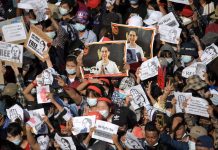
Japan may no longer prolong its state of emergency to revive the economy. The government is expected to make this announcement on Monday.
The Japanese government aims to ease restrictions on economic activity that are in effect in Tokyo and four other prefectures. The basis of ending the strict measures ahead of schedule is the country's success in controlling the spread of infections.
According to economic revitalization minister Yasutoshi Nishimura, an advisory panel supported the government's wish to end the emergency in the Tokyo metropolitan area including Chiba, Kanagawa and Saitama, as well as in Hokkaido in northern Japan.
Japan expects Prime Minister Shinzo Abe to announce his final decision regarding the state of emergency. There are no more restrictions in 42 of the country's 47 prefectures. The premier will face the press later in the day.
"After a comprehensive assessment, (the government believes) the state of emergency is no longer necessary in all prefectures," Nishimura, who is in charge of the virus emergency response, said during a meeting with the panel.
A transitional phase
Nishimura noted that the government will design and carry out a transitional phase. The government will also evaluate the infection situation every three weeks.
This means that the movement of people particularly in huge public events may be eased only gradually.
Nishimura stressed that people will not be fully allowed to cross prefectural borders until the end of May.
Among the areas studied by the panel of infectious disease and public health experts are the number of newly reported cases last week, access to medical resources, and the ability of the country to conduct virus tests and trace the spread of the virus.
One of the criteria is whether new infections have dropped below 0.5 per 100,000 people in the past week and all prefectures, except Kanagawa and Hokkaido, have cleared that threshold.
According to Japanese government officials, the 0.5 benchmark is not the only the basis. They noted that one of the factors is whether existing cases' transmission routes are traceable.
Lifestyle change
Moreover, Abe asks Japanese people to change their lifestyles. They can do so by wearing face masks, observing social distancing measures, and working from home. According to Abe, these practices will allow the lifting of the state of emergency to revive the economy. The Tokyo area and Hokkaido make up the third of the nation's gross domestic product.
Abe implemented the restriction measures in all 47 prefectures in mid-April, just in time for the Golden Week holidays from late April to early May.
Earlier in May, Abe announced the extension of the state of emergency until May 31. However, on May 14, he already lifted it in 39 prefectures where the spread of the virus had already been managed. This was followed by Kyoto, Osaga, and Hyogo in western Japan last Thursday.
Under the state of emergency, prefectural governors can legally request people to avoid nonessential outings and businesses to halt their operations, even though Japan cannot impose a hard lockdown similar to those happening in Europe and the US.
The Tokyo metropolitan area is the region that has been hit the most by the coronavirus outbreak, with more than 5,100 cases. The nation's capital has a population of 14 million.
The governors requested the central government to consider the four prefectures, Chiba, Tokyo, Saitama, and Kanagawa, as one. This means that any decision to ease the restrictions could be applied to all of them due to their geographic proximity and interlinked economies.
Meanwhile, Tokyo Governor Yuriko Koike laid out a three-stage plan to ease restrictions imposed over the coronavirus. With this, restaurants and eateries can operate longer and schools can conduct classes gradually.






